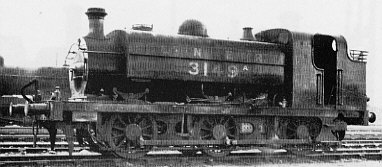The Stirling J57 (GNR J18) 0-6-0ST Locomotives

Stirling designed these saddle tanks in 1882, to work the dock traffic to London's East End. To reach the docks, these engines had to pass under the Great Eastern Railway's (GER) main line at Stratford Low Level station. At the time the headroom was a low 11ft 6in, hence small 4ft 0.5in wheels were fitted. Otherwise, they were very similar to the concurrent J54 locomotives. Two engines were built in 1882 to replace a couple of aging outside frame 0-6-0s. These were followed by six more in three batches of two each (in 1884, 1890, and 1892).
The frames had the same pattern of lightening cut-outs but were pitched 3in lower due to the smaller wheels. Tank, bunker, and frame length dimensions were all identical. The smaller wheels resulted in an increase in tractive effort, although this was partially offset by a reduction in cylinder stroke to 24in. The domeless 4ft 0.5in boiler was also very similar to the J54 boilers, although the barrel was 1in shorter. This was due to the smaller cylinders being mounted 1in further back, resulting in both the smokebox and chimney being mounted 1in further back.
The low loading gauge also resulted in the cab height being reduced by 8in, and a special low brass cover was fitted encasing the Ramsbottom safety valves. The reduction in cab height meant that circular front windows would not clear the top of the saddle tank, and oval windows were fitted instead.

4ft 2.5in and 4ft 5in diameter domed boilers were fitted from 1917. Nos. 685 and 140A were fitted with 4ft 5in boilers in 1917-18. No. 3134A was rebuilt in June 1924, and No. 3687 in October 1928. The 4ft 2.5in boiler was fitted to No. 3149A in January 1927, and to 3134A in September 1929. Hence, three of the eight J57s kept their original domeless boilers until withdrawal. Some of these later boiler rebuilds also replaced the original Ramsbottom safety valves with Ross pop safety valves
Intended to work the lines from the GNR London depots to the East End docks over GER rails, six J57s were still allocated to the London area at Grouping (1923). By 1923, No. 134A was allocated Grantham and No. 140A was allocated to Doncaster. The LNER transferred No. 3686 to Ardsley, and No. 3685 to Doncaster. The remaining four J57s remained in the London area at Hornsey and Kings Cross.
Withdrawals started in 1929, and by the end of 1933 only one J57 remained. This was No. 3685 at Doncaster, which was finally scrapped in June 1938.
Technical Details
The details below are for the J57s with domeless boilers. The domed Diagram 11 boilers had larger heating surfaces (total heating surface of 1119 sq.ft.), 170psi boiler pressure. J57s with these boilers had a quoted tractive effort of 21,896 lb, an increase in total weight to 47t 4cwt and an increase in maximum axle load to 16t 12cwt.
| Cylinders (x2): | (inside) | 17.5x24in. |
| Motion: | Stephenson | |
| Valves: | Slide | |
| Boiler: | Diameter (max): | 4ft 0.5in |
| Length: | 10ft 1in | |
| Boiler Pressure: | 160psi | |
| Diagram No: | - | |
| Heating Surface: | Total: | 863 sq.ft. |
| Firebox: | 85 sq.ft. | |
| Tubes: | 778 sq.ft. (163x 1.75in dia.) | |
| Grate Area: | 16 sq.ft. | |
| Wheels: | 4ft 0.5in | |
| Total Wheelbase: | 15ft 6in | |
| Tractive Effort: | (at 85%) | 20,610 lb |
| Length: | 31ft 1.5in | |
| Weight: | 43t 6cwt | |
| Max. Axle Load: | 15t 12cwt | |
| Water Capacity: | 1000 gallons | |
| Coal Capacity: | 2t |
Preservation
None of the J57s survived into preservation.
Models
I am not aware of any models of the J57s in any scale.